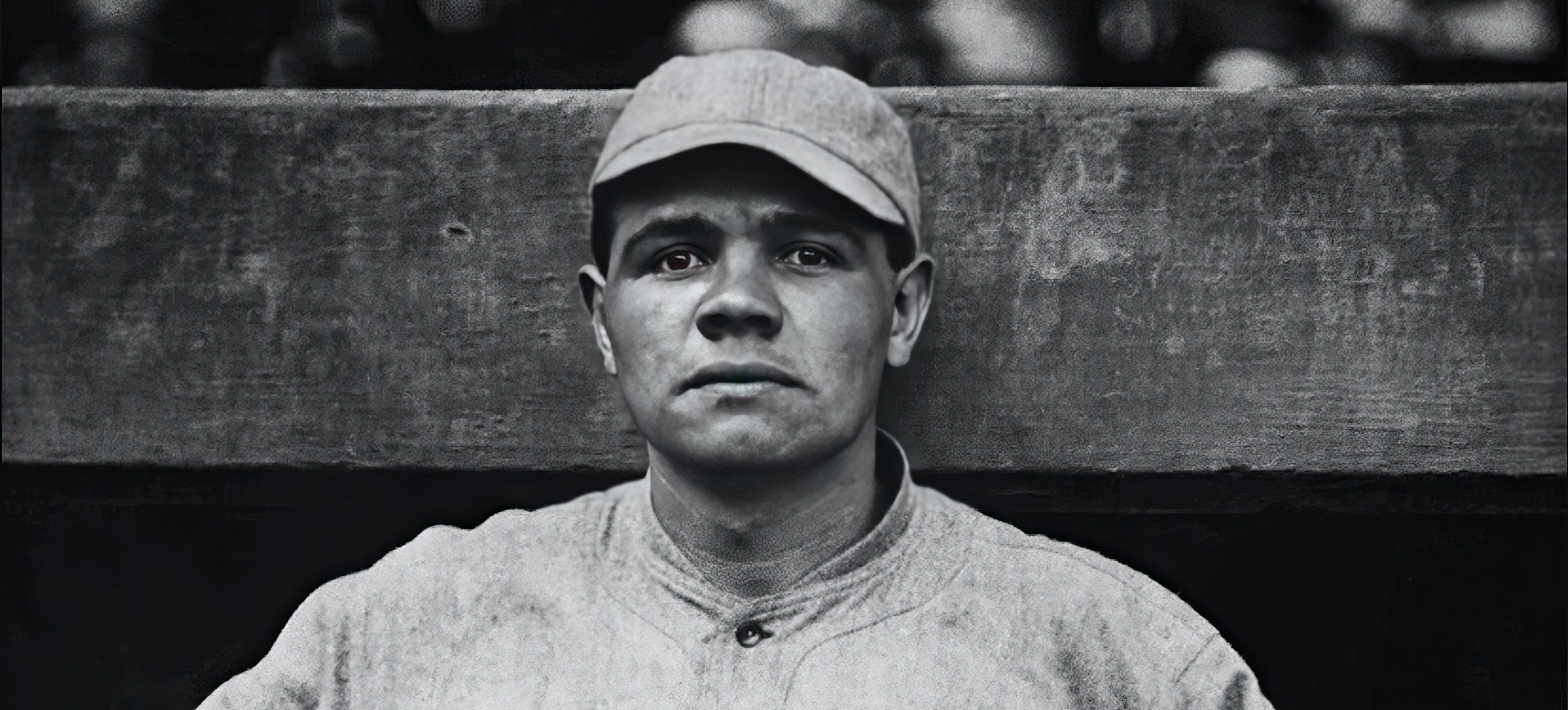
Science Explains Babe Ruth's Home Runs (Historical Reprint)
Historical article reprinted from the " Richmond Times-Dispatch", July 18, 1920, written by Prof. A.L. Hodges (The Well-Known Physicist)
Interesting Principles of Physics and Psychology Involved
in the 44 Horsepower Swing Which Shoots the Ball
Skyward at Six Miles a Minute
How Babe Ruth Grasps His Bat and
What Would Happen if a Gigantic Bat Were Swung Against a Skyscraper
with the Thousands of Horsepower Which All the Home Runs Ruth Has Made Last ?
* * * * *
Last season, Babe Ruth broke all baseball records by hitting 29 home runs. And this season there is every indication that he will beat his 1919 total by a wide margin.
What is the secret of Ruth's ability to make home runs with such surprising frequency? Is it because he is possessed of greater strength than his fellow players? Is it because his vision is keener or his muscles better coordinated?
All these things doubtless have something to do with it, but the real reason for this phenomenal series of home runs science finds to be the way Ruth applies to his work with the bat certain well-known principles of physics and psychology.
"But," you say, "Ruth is a ball player. What does he know of physics or psychology?"
Nothing, perhaps, but whether consciously or unconsciously, Ruth applies certain well-known principles of these two sciences every time he makes a home run. Let us consider some of the many interesting scientific factors involved in batting a ball.
As every follower of baseball knows, a home run is the knocking of the ball out of the reach of opposing players and in such a direction and to such a distance as to make its return impossible before the runner completes the circuit of the bases. Viewed as a mechanical problem, the hitting of a home run means simply hitting the ball with the bat so as to give it great speed in the proper direction. The speed and direction which the bat can be made to give the ball depend on the degree of the curve which the pitcher has imparted to the ball, the weight of the ball, the weight of the bat, the elasticity of the ball and bat, and the angle at which the ball impinges on the bat.
The speed which a ball takes on immediately after its collision with the bat is a little difficult to compute because neither the bat nor the ball is perfectly elastic or perfectly non-elastic. To illustrate the difficulty of such a computation let me explain what happens when perfectly elastic and perfectly non-elastic bodies come into collision.
If two inelastic bodies - say two pieces of lead - of equal weight, and going with equal speed, but in opposite directions, meet squarely "in mid-air, they will both stop and fall to the ground, all their energy of motion having been turned into heat. If, however, perfectly elastic bodies of the same weight going with the same velocity, but in opposite directions, meet in mid-air, they will bounce back with the same velocity they had originally. If one of these bodies has twice the velocity of the other, the latter will bounce back with twice its original velocity and the former will bounce back only half as fast. All this applies to bodies having the same weight. Whenever one of the colliding bodies is heavier than the other, the velocity given the latter body upon bouncing is enormously increased.
The bat which Babe Ruth wields and the ball which he hits are both fairly elastic, therefore, everything else being equal, the ball will be driven farther the heavier the bat and the faster the bat is moving as it hits the ball. Also, as the weight of Babe Ruth's body prevents his bat from doing much bouncing back, the faster the ball corner, the farther it will go when he hits it.

The weight of the ball itself is an important factor in hitting a home run, viewed us a scientific problem. If there were no atmosphere, everything being equal, the lighter the ball happened to be, the farther it would go. The friction of the air, however, slows the ball up considerably, and this fact has to be taken into consideration with several others.
The conclusion which science reaches is that the heavier the ball is, without increasing its size or decreasing its elasticity, the farther it will go after being struck with the bat.
The direction taken by a batted ball is affected to some extent by the rotation of the ball as it strikes the bat. This factor is of the greatest importance when the ;bat does not strike the ball squarely.
It is possible for the bat to hit the ball in such a way that it actually increases the latter's rotation. In other words, it is perfectly possible for the batter to hit the ball in such a way that it takes on a decided curve. Everybody who plays golf knows what a common occurrence this is on the links. A golf ball when struck accidentally off center will often describe the weirdest imaginable path through the air, particularly if it passes through various air currents.
A home run depends to a very large extent upon the direction given the batted ball. The importance of this factor may be estimated at nine times that of the speed given the batted ball. By direction we mean not only the horizontal angle, but also the vertical angle at which the ball leaves the bat. For example, no matter how hard the ball is hit, it will never result in a home run unless it clears the up-stretched arms of the players in the field.
It is plain that the direction given the batted ball must depend to a large extent upon the manner in which the ball is traveling before it meets the bat. Provided the ball is given a proper rotation on its horizontal axis by the pitcher, the kind of curve best suited to make it difficult to hit it at the proper vertical angle is either the down shoot or the up shoot. On account of the many variable factors concerned science believes that any home run made with either of these curves is a lucky chance pure and simple.
After the ball has been set in motion by the bat with a certain speed, the distance it will go depends upon the vertical angle at which it starts. The most desirable angle is one of 42-degrees with the ground, or about half a right angle. Other factors which determine the distance a batted ball will travel are the speed of the ball, its sphericity, the smoothness of its surface and its lack of rotation. The greater the speed of the ball the more perfectly spherical it is, the smoother its surface and the less rotation with which it travels, the farther it will go. Atmospheric conditions, of course, enter into the problem. A ball will go farther in a clear air that is free from moisture. The wind may carry it bodily for quite a distance or may retard its progress.
If science were asked to make it difficult or well-nigh impossible for Babe Ruth to hit a home run, it would select a day when the barometer was high, with the air so heavy with moisture that it would retard the progress of the batted ball. The pitcher selected would be one good on very slow but curvy down-shoots. If such a pitcher were not available, one who had such great speed that he could put any kind of a ball over the plate for the batter would be chosen. With this kind of a pitcher, the ball is likely to be hit behind the plate and unlikely to be started on its course at the proper angle. His hitting of a home run could then be made still more difficult by compelling the redoubtable Babe to use a bat either so heavy that he could not swing it with much speed, or so light that it would tend to hit the ball at the wrong horizontal angle.

There is a certain spot on the bat, usually a few inches from the end, but varying with different bats, which science knows as the center of percussion. If the ball hits the bat exactly on this spot the greatest effect is produced. All ball players are aware when the ball hits this spot on the bat, not only through the absence of jar to the arm, but also through a peculiar satisfaction which is hard to define, but which is no doubt physical as well as mental.
Babe Ruth's phenomenal home run record is largely due to the fact that, consciously or unconsciously, he has found a way of producing the collision between his bat and the ball on this center of percussion more frequently than any other player.
What is called the center of percussion is a principle that enters into the design not only of baseball bats, but of all things designed for men to swing. In the hammer, for example, the center of percussion should be in the head. If the tool is not designed so that this center is properly located, the hammer is unsatisfactory to use because it jars and tires the arm too much.
The problem of hitting home runs with the surprising frequency that Babe Ruth does, is one more complicated in the matter of powers of judgment and observation involved, than in mechanical principles. Viewed as a mechanical problem, the home run requires a bat just as heavy as a player can use with comfort, the bat to be given a motion as fast as possible when hitting the ball, and striking the ball so that it will be impelled into the air at an angle of approximately 42-degrees or half a right angle. The ball should also, of course, be hit at such a horizontal angle as not to cause a foul.
The weight of the batter has very little to do with the matter of home runs, but his arm muscles are a controlling factor to the extent of, say, fifty-percent. Of course, if his arms are rigid enough to make the bat for all practical purposes a part of his body when he hits the ball, and if his body is swung forward at just that instant, it is possible that a heavy batter, all other things being equal, would be able to knock the ball farther than a lighter player.
Home runs depend, to a considerable degree, on quickness of the eye and a speedy response of the body's muscles to the message which the eye flashes to the brain. To follow the ball as it leaves the pitcher's hand is no easy matter, as the sphere is often traveling at the rate of 150 feet a second, or nearly two miles a minute. The eye movement necessary to follow it increases greatly as the ball draws nearer and nearer the plate, owing to the increase in the angle of vision which, by the time the ball is over the plate, is about ten times what it was when it left the pitcher's hand.
As I have said, the pitcher often hurls the ball at the rate of 150 feet a second.
But the ball is traveling much faster than that when it leaves Babe Ruth's bat after being hit for one of the home runs that have made him famous. This is in accordance with the laws of the impact of elastic bodies.
All other things being equal, the faster a ball is thrown, the farther it can be batted. You can prove this to your own satisfaction by throwing a ball against a brick wall. The faster it travels, the harder it hits the wall and the farther it will bounce back.
Of course, if it is raining when one of Babe Ruth's long hits is made, the drops of water striking the ball will bring it to the ground long before it otherwise would fall. The rain also makes the ball heavier, and as it contains only so much energy to start with, it will be slowed up in its flight on account of some of the energy being used to give the captured raindrops their new velocity.

How much actual energy does Babe Ruth expend in hitting one of his home runs? The activity or horsepower involved is very great, but it is in operation only for the fraction of a second.
The ball which Babe Ruth hits for a home run weighs about five ounces. If a bat gives it a velocity of 500 feet a second, we find, by applying a well known formula of physics, that 1,200 foot pounds of actual energy or work is done. Now, if it takes Ruth one-twentieth of a second to impart this energy by a swing of his bat, this would be at the rate of 24,000 foot pounds a second, which is about 44-horsepower.
The king of home run makers is then working at the rate of 44-horsepower every time he cracks out one of his long hits, but he maintains this rate for such a brief length of time that not very much actual work is involved.
But if the energy exerted by Babe Ruth in all the home runs he has made up to date could be collected into a single force, it would be a very enormous thing. Twenty-nine such runs last season and more than a score thus far this year - this would be the equivalent of more than 2,000-horsepower - enough if exerted behind a gigantic bat to demolish a building like New York's Metropolitan Tower!
Of course, there are many psychological, as well as mechanical, factors involved in the hitting of the long series of home runs which Babe Ruth has been making for two seasons. The batter must be able to "sense" in some manner not yet fully understood just about what kind of ball the pitcher is going to throw. Then he must be capable of putting his body in readiness with lightning swiftness to meet that kind of ball when it passes over the plate. The player's judgment about the ball must be made within the smallest fraction of a second after it leaves the pitcher's hand.
Through some queer sixth sense - the kinesthetic sense, as psychologists call it - all batters have the feeling as to whether the ball the pitcher is about to throw is going to pass over the plate or not. In the average batter the impressions conveyed by this sixth sense cannot be more than 60-percent accurate, but in the case of Babe Ruth, as his batting record shows, they must be about 90-percent accurate. As everybody who plays baseball or ever watches a game knows, you can't strike out and make a home run. and the player can seldom hit a home run unless the bail he strikes is taking a course that would have carried it straight across the plate unless interrupted by his bat.
This, then, is the secret of Babe Ruth's home runs as viewed from a scientific standpoint. A highly developed kinesthetic sense enables him to "sense" the kind of ball the pitcher is going to throw.
When a ball rotating on its horizontal axis and curving most favorably for his purpose comes along, he swings his bat at it with an energy sufficient to change its direction and greatly increase its velocity. The bat is swung in such a way that the center of percussion meets the ball, sending it upward at an angle of 42-degrees and not too far to the right or the left.
When all these things happen, the result should be a home run, provided that the pitcher has given the ball proper speed and that the wind and other atmospheric conditions are favorable.


[A] The ball as it leaves the pitcher's hand, rotating on its horizontal axis and traveling at an initial velocity of 150 feet a second or nearly two miles a minute.
[B] The center of percussion of Babe Ruth's bat, swung for one-twentieth of a second with a force equivalent to 44-horsepower, meets the oncoming ball, checks its course toward the catcher's waiting hands, and sends it speeding at greatly increased velocity in an entirely different direction.
[C] The ball immediately after its impact with the bat, moving skyward at an angle of 42-degrees and with an initial velocity estimated at 500 feet a second or nearly six miles a minute - faster than any express train travels.
[D] Maximum height reached by the ball as a result of its collision with the bat's center of percussion, backed up by Mr. Ruth's 48 horsepower energy. The height attained will be greater on a clear day than on one when the air is full of moisture.
[E] Slowed down by the friction of the air, the force of gravitation begins to overcome the ball's initial velocity and it starts falling to earth. Before the full effect of the gravitational force is felt, however, the ball has traveled far beyond the fielder's reach and Babe Ruth has scored another home run.


































